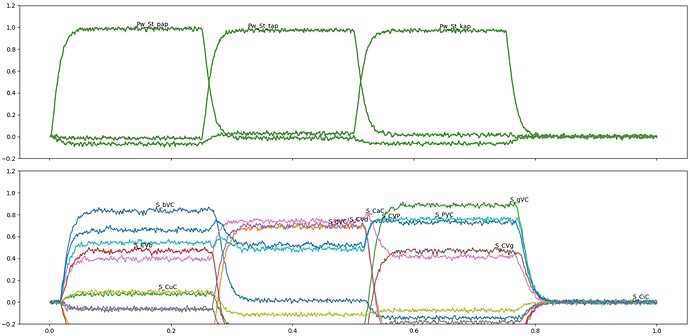Dear all
I have two state maps with different vocabs:
model.syll_phono = State(
subdimensions=subdims, neurons_per_dimension=n_neurons,
vocab=vocab_syll_phono)
with vocab:
vocab_syll_phono_keys = [‘Pw_St_pap’, ‘Pw_St_tap’, ‘Pw_St_kap’]
and
model.syll_score = State(
subdimensions=subdims, neurons_per_dimension=n_neurons,
vocab=vocab_syll_score)
with vocab:
syll_score_keys = [
# pap, tap, kap, …
‘S_bVC’, # 0
‘S_dVC’, # 1
‘S_gVC’, # 2
‘S_CVb’, # 3
‘S_CVd’, # 4
‘S_CVg’, # 5
‘S_CaC’, # 6
‘S_CiC’, # 7
‘S_CuC’, # 8
‘S_PVC’, # 9
‘S_CVP’, # 10
]
and a mapping between them:
mapping_syll_phono2score = {
# pap, tap, kap, …
‘Pw_St_pap’: ‘S_bVC’,
‘Pw_St_pap’: ‘S_CVb’,
‘Pw_St_pap’: ‘S_CaC’,
‘Pw_St_pap’: ‘S_PVC’,
‘Pw_St_pap’: ‘S_CVP’,
‘Pw_St_tap’: ‘S_dVC’,
‘Pw_St_tap’: ‘S_CVb’,
‘Pw_St_tap’: ‘S_CaC’,
‘Pw_St_tap’: ‘S_PVC’,
‘Pw_St_tap’: ‘S_CVP’,
‘Pw_St_kap’: ‘S_gVC’,
‘Pw_St_kap’: ‘S_CVb’,
‘Pw_St_kap’: ‘S_CaC’,
‘Pw_St_kap’: ‘S_PVC’,
‘Pw_St_kap’: ‘S_CVP’,
}
My problem: if I implement a association from syll_phono state map to syll_score state map by using:
assoc_mem_syll_phono2syll_score = ThresholdingAssocMem(
input_vocab=vocab_syll_phono, output_vocab=vocab_syll_score,
mapping = mapping_syll_phono2score, threshold=0.3, function=lambda x: x > 0.)
and
syll_phono >> assoc_mem_syll_phono2syll_score
assoc_mem_syll_phono2syll_score >> syll_score
then, I want to get ALL S-pointers in syll_score which are defined in the mapping for syllable /pap/, /tap/ or /kap/
… I will attach an (failing) py code example for this problem
Is it possible to have an additive overlay of these result S-pointers in syll_score state map?
Kind regards
Bernd
Kroeger_one2many.py (5.4 KB)
